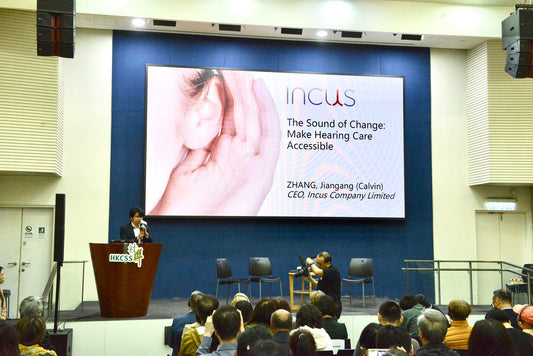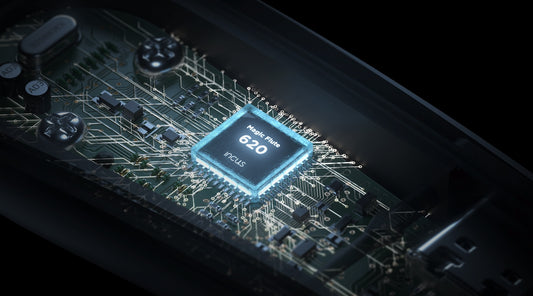What Are Hearing Aids?
Hearing aids are wearable devices designed to compensate for hearing loss. They amplify sounds to make them audible to the wearer. Similar to how eyeglasses help correct our vision, hearing aids are a remedy for hearing loss.
Typically, hearing aids have one or several microphones that pick up sounds from the surroundings.
The sounds are amplified by amplifier circuitry, and the resulting amplified sounds are produced by a loudspeaker. Hearing devices are powered by batteries, which are either rechargeable or replaceable.

When Can Hearing Aids Help?
Hearing aids are designed to compensate for sensorineural hearing loss, which means damage to the inner ear. This is the most common type of hearing loss and can be caused by ageing, exposure to noise, certain diseases, physical trauma to the ear or the head, as well as some types of medications or drugs.
When some of the cells in the inner ear are damaged, the result is reduced sensitivity to sounds. Hearing devices amplify sounds so that the remaining, functioning cells can sense them.
The greater the extent of the damage to the inner ear cells is, the more severe the hearing loss is. Hearing aids are adjusted accordingly to give the right amount of amplification.
The Limitations of Hearing Aids
When it comes to treating hearing loss, hearing aids have 3 main limitations:
- Hearing aids cannot cure hearing loss.
- If the hearing loss is too severe, it may not be treatable with a hearing aid.
- If the hearing loss is conductive or mixed instead of sensorineural, it means that sounds are not able to reach the inner ear in the first place.
In cases of conductive or mixed hearing loss, regular hearing aids, which rely on the flow of sound through the air (air-conduction) to the ear canal, may not be the right option. Instead, it may be necessary to use bone-conduction hearing aids. They function by generating vibrations in the bones at certain frequencies and thereby transmitting sounds to the inner ear.
How Can I Find Out if I Need a Hearing Aid?
The type and degree of hearing loss will influence whether a hearing aid is suitable for you.
Before deciding to get hearing aids, you should therefore see a hearing care professional or audiologist for a full evaluation of your hearing.
During the consultation, the hearing care professional should complete most of the following items:
- Case history
- Otoscopy: visual inspection of the ear canal
- Auditory assessment: hearing tests and speech-in-noise test
- Review of results
- Referral to a physician for medical clearance (if applicable)
- The type and degree of hearing loss
What Are the Differences Between Hearing Aids and Personal Sound Amplifiers?
Hearing aids are medical devices intended to compensate for hearing loss. Because hearing aids are expensive and time-consuming to buy, some people opt for personal sound amplification products (PSAPs) instead. PSAPs are consumer electronics products instead of medical devices and are much cheaper than hearing aids.
Similar to hearing aids, they amplify sounds to make them easier to hear. However, personal sound amplifiers are not intended to compensate for hearing loss. They amplify all frequencies by the same amount rather than personalising the audio, and could therefore cause further damage to one’s hearing.
Besides, they tend to have lower quality and lack of advanced features like noise reduction and feedback management.
On the other hand, PSAPs are easier to access, handle and set up and some are disguised as regular Bluetooth earphones to avoid the stigma associated with traditional hearing aids.
How Smart Personal Sound Amplifiers Combine the Advantage of Hearing Aids and PSAPs
Recently, with the widespread adoption of smartphones, a new type of hearing devices has emerged: smart personal sound amplifiers.
Smart personal sound amplifiers combine the advantages of hearing aids and PSAPs:
- They are connected to smartphone applications, through which hearing assessments can be completed.
- The hearing test results are transmitted to the smart personal sound amplifier
- All sounds are personalised based on the hearing test results
- They have advanced audio processing features like noise reduction and feedback management
- They are easy to use and handle
- They are disguised as regular Bluetooth earphones
- They are powered by rechargeable batteries
- The user has the ability to fine-tune the settings through the smartphone app
- They can be purchased online
The drawback of smart personal sound amplifiers is that they are not medical devices - they are not intended to compensate for hearing loss.
The following table summarizes how smart personal sound amplifiers compare to traditional hearing aids and personal sound amplification products:
| Smart personal sound amplifiers | Traditional hearing aids | Personal sound amplification products | |
| Large buttons | Yes | No | Some |
| Disguised as regular earphone | Yes | No | Some |
| Easy to handle | Yes | No | Yes |
| Hearing test at home | Yes | No | No |
| Personalised sound | Yes | Yes | No |
| Advanced noise reduction and speech enhancement features | Yes | Yes | No |
| Price | $$ | $$$ | $ |
| Setup time | Minutes | Days-weeks | Minutes |
| Control via app | Yes | Some | Some |
| Rechargeable battery | Yes | Some | Some |
| Feedback (whistling) management | Yes | Yes | No |
| Buy online | Yes | No | Yes |
| Medical device | No | Yes | No |
Besides the high price, some people decide not to get hearing aids because the process is complicated and time-consuming.
The hearing aid fitting process is:
- Complete a pure-tone hearing test at the hearing care professional’s office
- Complete a speech-in-noise test (this step is often skipped)
- The hearing care professional fits the hearing aids based on the test results
- The customer goes back home to test the hearing aids out for 2-4 weeks
- The customer returns to the hearing care professional’s office to reprogram the devices if the customer is not satisfied
- Steps 4-5 are repeated until the customer is happy
It is easy to imagine that this process can be a time-consuming and frustrating experience.
PSAPs skip this entire process because they do not personalise the sounds to the user’s hearing.
Smart personal sound amplifiers, on the other hand, put the consumer in charge of the setup process. Smart personal sound amplifiers can be programmed at any time from the comfort of the home using a smartphone app if the user is not satisfied.
What Type of Hearing Device Is Best for Me?
A hearing care professional can help assess whether a hearing device would be beneficial and recommend suitable devices. They would consider your hearing health, lifestyle and the size and shape of your ears.
Important Questions You Need to Ask Before Buying a Hearing Aid
- Which features are the most useful to me?
- How much does the device cost?
- Is there a risk-free trial period available?
- If there is a risk-free trial period, are there any fees that are not refundable? Do they charge a restocking fee or shipping fee?
- How long is the warranty period?
- Does the warranty cover future maintenance and repairs? What are the procedures for making a warranty claim?
How Do Hearing Aids Work?
Depending on the technology-level of a hearing aid, it may also have various features like background noise reduction, feedback (whistling) management or Bluetooth audio streaming.
Modern hearing aids use digital signal processing techniques to power advanced features.
The way hearing aids work can be summarized by the following hearing aid processing diagram:

It starts with the microphones picking up sounds from the surroundings. Those sounds are converted to digital signals. Essentially, sound waves are being converted into a collection of thousands of 0’s and 1’s per second.
The hearing aid has a chip, which carries out sophisticated processing on the digital signals. The most essential kind of processing is to personalise the sounds, especially speech, to make them easier for the wearer to hear. Advanced hearing devices will also perform actions like noise reduction and feedback cancellation at the same time.
After the processing is completed, the digital signal is converted to an analog signal, which is produced by the loudspeaker.
The entire process has to be completed within just a few milliseconds. If the time delay from input to output is more than around 20 milliseconds, it will feel like what your eyes see is out of sync with what your ears hear.
Those with mild to moderate hearing loss would also hear an echo effect, because they first hear sounds through their ears’ natural pathway, and then later through the hearing device.
The Advantages Digital Hearing Aids Have Over Analogue Devices
Modern hearing aids are called digital hearing aids because they use digital signal processing techniques. Historically, hearing aids were analogue. Analogue devices were difficult to personalise, and had only the most basic features. Typically, they would amplify all sounds - even background noise - in the same way.
Digital hearing aids offer more room for personalisation, and they can have more advanced features like background noise reduction. Rather than treating all sounds equally, they aim to amplify the sounds the wearer wants to hear, which is usually human voices.
Digital hearing aids can be reprogrammed more easily than analogue hearing aids. Adding or changing features in a digital hearing aid is as “simple” as giving the chip a new set of instructions.
That being said: Modern hearing aids are highly sophisticated devices. Good hearing aids exist only thanks to the hard work and ingenuity of audio technology researchers.
Image attribution:


